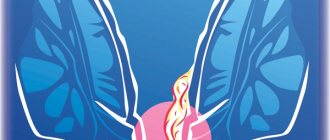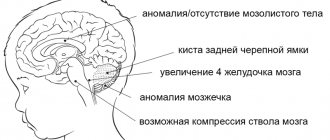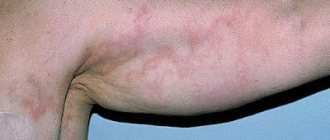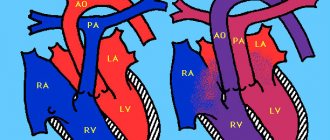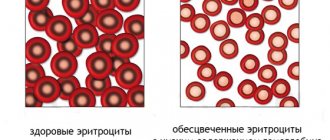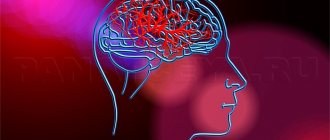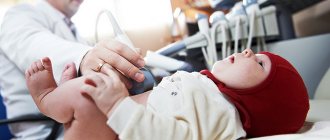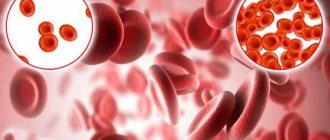The most acute period
Typical cases of myocardial infarction are characterized by extremely intense pain with pain localized in the chest and radiating to the left shoulder, neck, teeth, ear, collarbone, lower jaw, and interscapular area. The nature of the pain can be squeezing, bursting, burning, pressing, sharp (“dagger-like”). The larger the area of myocardial damage, the more severe the pain.
A painful attack occurs in waves (either intensifying or weakening), lasting from 30 minutes to several hours, and sometimes even a day, and is not relieved by repeated administration of nitroglycerin. The pain is associated with severe weakness, agitation, a feeling of fear, and shortness of breath.
What can affect the formation of atypical cells:
- Carcinogens.
- Prolonged exposure to ultraviolet rays.
- Low radiation.
- Electromagnetic radiation.
- Aggressive chemicals.
- Failure in the body.
- Inflammation and infection
- Natural aging.
These are some factors that can lead to the formation of atypical cells. Unfortunately, no one can say the exact cause of their occurrence. Even some minor malfunction in the body can lead to the appearance of not one or even two such cells, but thousands.
Acute period
In the acute period of myocardial infarction, pain syndrome usually disappears. The persistence of pain is caused by a pronounced degree of ischemia of the peri-infarction zone or the addition of pericarditis.
As a result of the processes of necrosis, myomalacia and perifocal inflammation, fever develops (from 3-5 to 10 or more days). The duration and height of the temperature rise during fever depend on the area of necrosis. Arterial hypotension and signs of heart failure persist and increase.
Publications in the media
Atypical mycobacterial infection is a complex of granulomatous lesions caused by mycobacteria that differ from the classical pathogens - the causative agents of tuberculosis and leprosy.
Etiology. Pathogens are acid-fast bacteria Mycobacterium ulcerans, M. marinum (M. balnei), M. kansasii, M. avium-intracellulare, M. xenopi, M. scrofulaceum.
Epidemiology. Most pathogens are widely distributed in the environment; some live in water and coastal zones, causing diseases in fish, others (for example, Mycobacterium avium-intracellulare) - in birds. Most often, infection occurs through inhalation of mycobacteria, consumption of contaminated products, and penetration of the pathogen through microtraumas of the skin and mucous membranes.
Pathogenesis. Invaded mycobacteria are phagocytosed by macrophages and transported to regional lymph nodes; phagocytic reactions are incomplete, and the pathogen persists in the cytoplasm of macrophages. The inflammatory reaction is insignificant, but a primary affect develops at the site of penetration. Over time, along the regional lymphatic pathways and nodes, a primary complex is formed, characterized by the development of granulomas. Microscopy of biopsy specimens reveals foci of non-caseating necrosis containing acid-fast bacteria.
Clinical picture
• Tuberculosis-like lesions. The pathological process involves the lungs, kidneys, skin and osteoarticular system. Often complicate the course of emphysematous processes. In 40–50% of patients with immunodeficiency conditions, generalized lesions are caused.
• Lymphadenitis. Clinically, they are more often manifested by lesions of the cervical lymph nodes (the so-called scrofula); the latter are painless, can ulcerate or drain outward; systemic manifestations are weak or often absent.
• Skin lesions. Infection of wounds of the extremities received when hitting the wall of the pool or any object on the bottom and banks of the reservoir is considered typical. More often, the formation of an ulcerating granuloma is observed, which is spontaneously limited within a few weeks; in more rare cases, a chronic infection forms.
• Less commonly observed are chronic pulmonary lesions in middle-aged people, which have now been reported everywhere. Possible bursitis of the elbow joint with repeated injuries and skin lesions, cervical lymphadenitis and carpal tunnel syndrome in people with immunodeficiencies (most often after therapy with hormonal drugs).
Research methods • Isolation and identification of the pathogen by growth rate, formation of pigments (in the light or in the dark) and pathogenicity for laboratory animals • Antibodies to Mycobacterium kansasii cross-react with Ag from Mycobacterium tuberculosis and a positive Mantoux test is noted in infected individuals.
Differential diagnosis • Leprosy • Tuberculosis • Borreliosis • Plague.
Treatment • For pulmonary lesions •• A combination of isoniazid 600 mg, rifampicin 300 mg, streptomycin 1 g and ethambutol 15–25 mg/kg 1 time per day is recommended •• For M. marinum lesions - minocycline 100 mg every 12 hours for 6 –8 weeks •• For lesions of M. kansasii and M. xenopi, standard anti-tuberculosis therapy is effective with mandatory administration of rifampicin •• Surgery is recommended for localized lesions in young patients without pathology of other organs and systems • For lymphadenitis - in children from 1 to 5 years, surgical treatment is indicated • For skin lesions caused by M. marinum - tetracycline (1-2 g/day) and a combination of rifampicin and ethambutol for 3-6 months • For infections caused by wounds or foreign bodies •• Surgical debridement and removal of a foreign body •• Drug therapy: doxycycline (200–400 mg/day), cefoxitin (200 mg/kg/day), amikacin (10–15 mg/day) for 3–6 months • For disseminated lesions - a combination of antituberculosis drugs drugs (as for pulmonary lesions) only reduces bacteremia and temporarily relieves symptoms.
Course and prognosis. The course is progressive. More than 20% of patients experience relapses of the disease within 5 years.
ICD-10. A31 Infections caused by other mycobacteria
Atypical forms of myocardial infarction
Sometimes there is an atypical course of myocardial infarction with localization of pain in atypical places (in the throat, fingers of the left hand, in the area of the left scapula or cervicothoracic spine, in the epigastrium, in the lower jaw) or painless forms, the leading symptoms of which may be cough and severe suffocation, collapse, edema, arrhythmias, dizziness and confusion.
Atypical forms of myocardial infarction are more common in elderly patients with severe signs of cardiosclerosis, circulatory failure, and secondary myocardial infarction.
However, only the most acute period usually proceeds atypically; further development of myocardial infarction becomes typical.
The erased course of myocardial infarction is painless and is accidentally detected on an ECG.
Antibiotics
FOR INFORMATION FOR PATIENTS
Antibiotic resistance is a serious health threat!
“Increasing drug literacy of the population -
This is what is an integral part of a solid attitude towards one’s health.”
N. Nazarbayev
- Winter, however. It's time to get sick and get treatment. And go to the pharmacy . One of the most hated questions for pharmacists is: “Will you give me some kind of antibiotic?” But why “hated”? Such emotions are not difficult to understand: the vast majority of colds cannot be cured with antibiotics.
Probably, few of us think that humans live in a world of bacteria. They live both outside and inside us. Antibiotics do deal a strong blow to pathogenic bacteria, but at the same time they also cause irreparable harm to the entire body.
Currently, antibiotics, and indeed any medicines, are freely available. And that is why their unreasonable use often leads to counter-productive results.
- Why is this so relevant? Because in medicine there is the concept of resistance (stability) - the ability of an organism (any living thing) to resist or counteract all influences harmful to it. Recently, in all areas of activity related to healthcare, animal breeding, food industry, etc. The rapidly growing resistance of dangerous microorganisms to all traditional disinfecting materials was noted, and in such a progression that it required the development of a radically new approach to cleaning and disinfection preparations.
- What does this mean for a person? You are treated with the right antibiotic, but nothing helps. Why is this happening? Bacteria have the ability to adapt. By changing their properties, they adapt to antibiotics and do not perceive them.
Currently, antibiotics are used too often, both by doctors and patients themselves. The concept is this – as long as the patient is satisfied.
- The most important thing to know about antibiotics is that they are not effective against viruses, they only fight bacteria, some types of parasites and fungal infections. Colds, flu, bronchitis, runny nose and many other diseases that we love to treat with antibiotics are most often of a viral nature and extremely rarely - bacterial.
- Only the doctor decides when to use antibiotics!
Often colds (of any origin) last only 5-7 days and the only thing that can be done is to relieve the symptoms. But sometimes, when a bacterial infection occurs, the doctor may prescribe antibiotics.
It can be difficult to distinguish a viral infection from a bacterial one. Sometimes laboratory tests are even required. For example, it is impossible to determine what caused a sore throat just by looking at it. The cause may be a virus, irritants in the air, or streptococcal (bacterial) infection. Only in the latter case are antibiotics prescribed, including to prevent the development of complications (rheumatism, and with it heart disease, etc.).
- Viruses and bacteria are two very different things.
Antibiotics are nothing more than waste products of microorganisms (most often fungi) and their synthetic derivatives. They either cause the death of bacteria or prevent their growth and reproduction.
Viruses, which also cause infections, are smaller in size than bacteria, but are more advanced microorganisms that act according to a more complex pattern.
- Why can’t you self-prescribe antibiotics?
All antibiotics, despite differences in chemical structure and mechanism of action, share a number of unique qualities.
Firstly, the uniqueness of antibiotics lies in the fact that, unlike most other drugs, their target - the receptor - is not located in human tissues, but in the cell of a microorganism.
Secondly, the activity of antibiotics is not constant, but decreases over time, which is due to the formation of drug resistance (resistance). Resistance develops through unnecessary and frequent use of antibiotics and if you do not complete the entire course of treatment. Antibiotic resistance is an inevitable biological phenomenon and it is almost impossible to prevent it.
Thirdly, antibiotic-resistant microorganisms pose a danger not only to the patient from whom they are isolated, but also to many other people, even separated by time and space. Therefore, the fight against antibiotic resistance has now become global.
Example: pneumonia - treatment for 10 - 14 days, urinary tract infection - up to 20 days. This is not done for the purpose of “pumping out” money. It is necessary to eliminate all pathogenic pathogens. If you take an antibiotic for 3-4 days, you feel better, and you stop taking it, then there is zero point in such treatment. All the same, some bacteria will survive and adapt by mutation during reproduction.
This is especially true in pediatrics. As soon as the child feels unwell, a sign of acute respiratory viral infection, we immediately give him an antibiotic. In the future, these children may become resistant to antibiotics.
You should not go to the pharmacy and rely on the opinion of pharmacists. Why? First of all, you don’t know what bacteria caused your illness. And buying an antibiotic in such a situation is no different from buying it blindly (wherever I point my finger, that’s mine). Despite the fact that the antibiotic has no effect on the virus!!! Secondly: if you ask a pharmacist for advice, he will offer you a broad-spectrum antibiotic. Thirdly: you will not survive the entire course of treatment, because... don't know him.
If you take antibiotics strictly according to your doctor's instructions, the likelihood of developing side effects is reduced to a minimum. But it still exists and depends on the individual characteristics of the organism and the type of antibiotic.
- But the most important thing: to avoid bacterial infections and remember about antibiotics as little as possible, it is enough to regularly wash your hands with soap (not necessarily antibacterial), especially after visiting the toilet, before eating, and also after contact with raw meat!
- Antibiotics should only be prescribed by a doctor for certain indications, because the choice of antibiotic depends on the nature and severity of the disease, as well as on what medications the patient has previously received. And only the doctor decides on replacing the antimicrobial drug.
- What antibiotics don't do:
- do not act on viruses;
- do not reduce body temperature;
do not prevent the development of bacterial complications.
- When taking antibiotics you need to know:
- Like all other medications, antibiotics should only be prescribed by a doctor!
- If you are being treated with antibiotics, do not stop taking them immediately after you feel better. Only a specialist should determine the time of treatment.
- Do not ask the doctor, or especially the pharmacy, to give you something stronger. These medications are not always more beneficial.
- Parents should know when and in what doses the child took medications. Without this information, the specialist will not be able to correctly prescribe antibiotics. It is best to write down the names of the medications you give your baby. In addition, pay attention to any manifestations of allergies.
- You do not need to adjust the dosage of the drug prescribed by your doctor yourself. Antibiotics can be dangerous in small quantities because they can cause the development of resistant bacteria.
- Strictly follow the instructions for taking a particular drug.
- Measures to overcome side effects are also determined by your doctor.
Unreasonable use of antibiotics:
— leads to an increase in microflora resistance (in the future this drug will no longer help);
— leads to disruption of the normal microflora of the body (though not always, but only when prescribed incorrectly);
— increases the risk of developing undesirable reactions (allergies, disruption of enzymatic work, etc.);
- leads to increased treatment costs.
Thus, taking antibiotics disrupts the natural microflora, resulting in a sharp decline in immunity. And then there is an easy opportunity for many bacteria to penetrate the body - this is how a person becomes ill with serious diseases. Therefore, after treatment with synthetic antibiotics, the body becomes practically unprotected from various dangerous bacteria.
Remember where the name “antibiotic” came from - “ antibios ” - against life!!!
Diagnosis of myocardial infarction in women and men
The diagnosis is made based on three criteria: clinical manifestations, laboratory results and electrocardiogram indicators. However, the diagnosis of myocardial infarction in women has some peculiarities.
Symptoms: tearing pain behind the sternum radiating to the left side of the body, cold sweat, increasing weakness, lack of air. There may be a drop in pressure. The pain, as a rule, is not relieved by a nitroglycerin tablet.
ECG signs of myocardial infarction: the presence of Q waves and ST segment elevation.
Laboratory tests: a sharp increase in the blood of specific markers of damage to heart muscle cells.
Algorithm for providing assistance in case of myocardial infarction (before the ambulance arrives):
- lay the patient down and raise the head of the bed;
- give nitroglycerin and aspirin again;
- The use of Corvalol (Valocardine), Baralgin and Panangin is recommended.
On our website you will find more detailed information on this issue. Rehabilitation after myocardial infarction, preventive measures, features of the manifestation of the disease in old age - questions that our specialists will answer.
Mycoplasma atypical pneumonia
The causative agent of the disease is mycoplasma. Atypical pneumonia is diagnosed in children in 21% of cases, in adults – in 25%. Children aged 3 to 14 years are most often affected. The infection is spread by airborne droplets.
The incubation period lasts from 3 to 11 days. This is followed by a short prodromal period, which lasts up to 1 day. The main symptoms of mycoplasma atypical pneumonia are:
- moderate headache;
- general malaise;
- dry, sore or sore throat;
- dry cough;
- low-grade fever.
During the examination, the doctor reveals redness and enlargement of the follicles on the back wall of the pharynx. The cough that appears at the beginning of the disease gradually increases. It becomes paroxysmal, but remains unproductive for 2-3 weeks. When lung tissue is damaged, the patient's condition worsens, body temperature rises, chills and signs of intoxication appear.
A feature of mycoplasma atypical pneumonia is the discrepancy between physical changes and x-ray data and the lack of effect of treatment with penicillin antibiotics or cephalosporins. On days 3-5, during auscultation, weakened breathing and a small amount of moist rales are heard. Mycoplasma atypical pneumonia can be suspected by the presence on radiographs of a low-intensity or moderate-intensity heterogeneous shadow of infiltration, which is visible against the background of a sharply changed pulmonary vascular pattern.
To diagnose mycoplasma atypical pneumonia, doctors at the Yusupov Hospital use the following methods:
- microbiological (culture of sputum and nasopharyngeal swabs on special nutrient media);
- serodiagnosis (complement fixation reaction);
- detection of mycoplasma antigens in human biological environments.
Express diagnosis of atypical pneumonia is carried out using DNA and RNA probes.
For the treatment of mycoplasma atypical pneumonia in adults, antibacterial drugs of the macrolide group and lincosamides are used. Children over 8 years of age and adults are prescribed doxycycline. With the development of broncho-obstructive syndrome, the use of bronchodilators is indicated.
Treatment
Treatment of a patient with myocardial infarction is carried out by a resuscitator in the intensive care unit or a cardiologist in a specialized department (infarction department). Therapy for this disease has the following goals:
- relieve pain;
- limit the spread of necrosis;
- restore coronary blood flow;
- prevent early complications.
The patient is given complete physical and mental peace. Bed rest is prescribed for 3 days. Pain syndrome is relieved with narcotic analgesics (morphine, promedol). In addition, oxygen inhalations are prescribed, which reduce oxygen starvation and ischemia.
In the first 6 hours from the onset of the attack, thrombolytic therapy (dissolution of blood clots) is carried out. Prevention of increased blood clotting and prevention of the formation of new blood clots is carried out with anticoagulants (heparin) and antiplatelet agents (aspirin, dipyridamole).
Nitroglycerin continues to be taken. The heart rate is reduced with beta-blockers (atenolol, metaprolol). To reduce the concentration of cholesterol in the blood, statins (lovastatin, pravastatin) are indicated.
Treatment in a hospital lasts on average 21-28 days, after which the patient undergoes outpatient rehabilitation. A patient who has suffered a myocardial infarction is recommended to eat a diet limited in fats and carbohydrates, but enriched with fresh vegetables and fruits, aspirin is prescribed (for life) and metabolic therapy (ATP, cocarboxylase, potassium preparations, riboxin, vitamin E) is continued.
Overweight patients need to lose it. Regular moderate and low intensity physical activity (walking and physical therapy) is also indicated.
The prognosis for myocardial infarction depends on how quickly treatment is started, the size of necrosis, the location of the lesion, and the severity of the disease.
Reasons for development
The development of the inflammatory process in the lungs is associated with the vital activity of pathogenic microorganisms with different characteristics. This causes a variety of forms of atypical pneumonia. Atypical pneumonia is most often detected in children and young people. The causes of atypical pneumonia are the following pathogens:
- coronavirus;
- mycoplasma;
- chlamydia;
- legionella;
- Coxiella;
- influenza viruses A, B;
- respiratory syncytial virus;
- hantavirus.
In the early stages, diagnosis of the disease is difficult. Therefore, pulmonologists recommend that if signs of an inflammatory process in the respiratory tract appear, you should go to the Yusupov Hospital for an examination under the guidance of candidates and professors of medical sciences.
The main difficulty in the treatment of atypical pneumonia is mutations of pathogens, as a result of which their resistance to drugs increases. When treating patients at the Yusupov Hospital, drugs are used whose effectiveness has been confirmed by many studies. At the same time, patients are prescribed only those medications that are certified in the Russian Federation.
